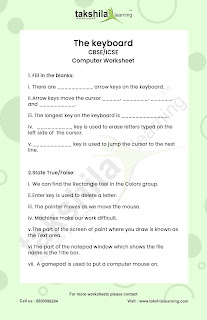NCERT Class 4 Computer Science - Computers Worksheet The keyboard
1. What is a keyboard?
2. When did the first keyboard invent?
Typewriter keypunches and teleprinters were two inventions that aided in the development of the computer keyboard. The first writing machines were invented in the 1700s, and Henry Mills filed a patent in 1714 in London, England.
3. Complete the following sentences:
- On the keyboard, there are _________ arrow keys.
- The cursor moves using the arrow keys _____, _______, ______, and .
- On the keyboard, the longest key is _____.
- The _________ key is used to delete letters typed on the cursor's left side.
- The __________ key moves the pointer to the next line.
3. State True/False:
- We can find the Rectangle tool in the Colors group.
- Enter key is used to delete a letter.
- The pointer moves as we move the mouse.
- Machines make our work difficult.
- The part of the screen of paint where you draw is known as the Text area.
- The part of the notepad window which shows the file name is the Title bar.
- A gamepad is used to put a computer mouse on.
Read more

Comments
Post a Comment
Thank you we will contact ASAP.